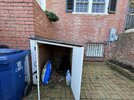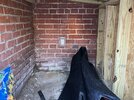Hello,
So after reading many posts on here my only home charging option is the 240V external outlet with a 30 Ft extension cord.
What are my options or recommendations when NOT charging the Tesla?
Unplug the cord every time?
Or can I have the electrician add an On/OFF switch?
Thanks
So after reading many posts on here my only home charging option is the 240V external outlet with a 30 Ft extension cord.
What are my options or recommendations when NOT charging the Tesla?
Unplug the cord every time?
Or can I have the electrician add an On/OFF switch?
Thanks







